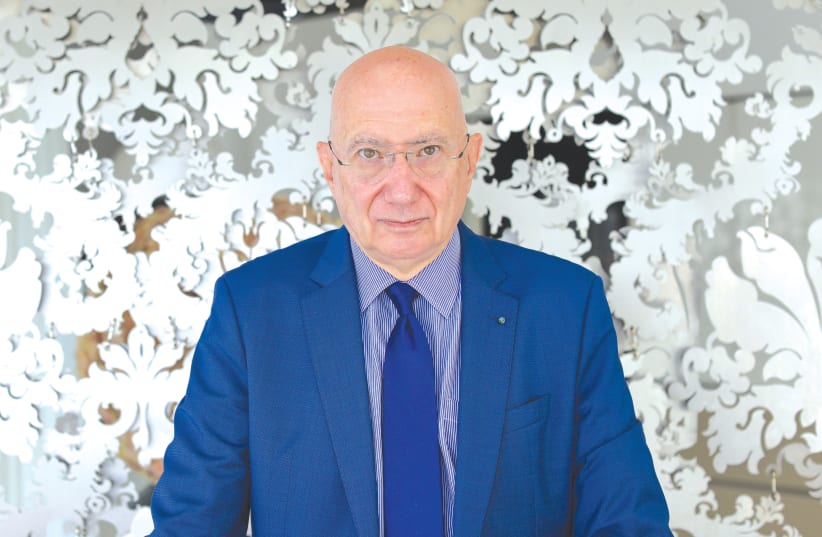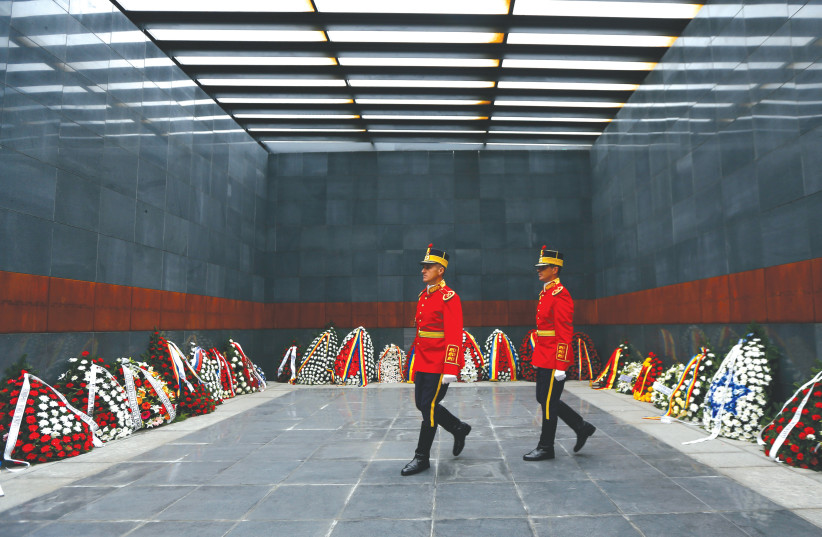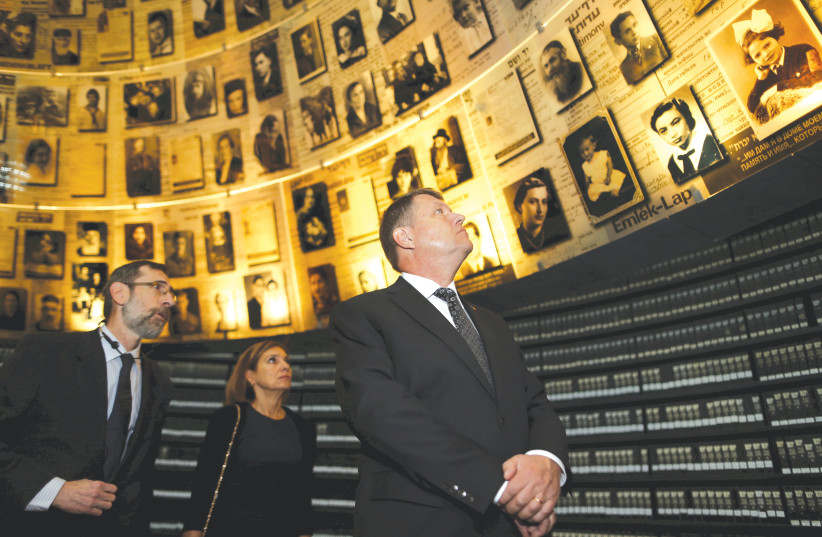When Romanian President Klaus Iohannis offered historian Radu Ioanid an ambassadorship, Ioanid said there was only one country in the world where he would want to serve: Israel.
Born in Bucharest to a Jewish father and a Protestant mother, Ioanid’s connection to Israel goes beyond his ancestry.
His research into Romania’s role in the Holocaust made him an enemy of Romania’s communist regime, which he escaped.
In the subsequent decades, as the premier historian of the Holocaust in Romania and the director of the US Holocaust Memorial Museum’s International Archival Programs Division, he has clocked many hours in Yad Vashem and other archives throughout the country over decades of research.
One of Ioanid’s books, The Ransom of the Jews: The story of the extraordinary secret bargain between Romania and Israel, which came out in a new edition this year, revealed that Israel paid Ceausescu’s Romania thousands of dollars per person to allow over 100,000 of the country’s Jews to emigrate to Israel.
Ioanid shared his extraordinary life story with The Jerusalem Post this month from the ambassador’s residence in Herzliya, which he shares with his wife, five cats – including one named after perhaps the most famous Romanian in literature, Dracula – and a Dachshund named Felix.
“I grew up in a family in which both parents were university professors,” Ioanid recalled. “Though they were left-wing, and at a certain point my father was a communist, they were very against the Ceausescu regime.”
The Ioanid family home was full of books – “which is not rare in a part-Jewish family,” he quipped – and Western periodicals like Le Monde and L’Expresse that his father would buy on the black market.
Ioanid chose to study sociology because it was viewed as a “bourgeois” topic in communist Romania, and therefore, was less under the thumb of official ideological dictates.
“I profoundly disliked the Ceausescu regime, and I realized at a certain point that the regime looks more and more like a fascist one,” he says. “The political extremes are very similar,” an idea known as the Horseshoe Theory.
“The regime was a national socialist regime,” Ioanid added, using the full meaning of Nazi. “Even certain rallies started to look like Nazi rallies, and Ceausescu also started to rehabilitate Romanian fascists and praise them and attempt to justify them.”
Ioanid wrote his PhD on fascism in Romania at the University of Cluj, under an advisor who had survived the Holocaust. He had no access to primary sources, as the communist regime kept its archives closed, but the academic library had old Romanian fascist newspapers and the testimonies at trials of Romanian war criminals, among other sources.
“Unlike the regime, which officially said Romanian fascists were the fifth column of Nazi Germany, I demonstrated in my thesis that it had grassroots origins,” he explained. “It was a mystical, religious, clerical Orthodox Christian type of fascism and not a Nazi political party.”
The Ceausescu regime did not like his dissertation, to say the least, though Ioanid hesitates to call himself a dissident.
“I was denied a passport and told I can’t participate in international conferences, and ultimately, I wasn’t able to publish my thesis in Romania until the fall of communism… They recruited a network of informants in my workplace who said I’m not loyal to the regime – which was true – and that I was writing things out of sync with the official propaganda.”
After the regime fell, Ioanid was able to read his entire secret police file, and he knows exactly who informed on him, including preeminent sociologists.
“It’s a strange feeling,” he said of being watched. “You feel like something is not right, but you don’t know what.”
At age 33, Ioanid and his wife received an exit visa in 1977 to go to Israel, but decided to emigrate to the US instead because he spoke English. He began working at the American Jewish Archives in Cincinnati, where he continued his research of the Holocaust in Romania.
In 1989, Ioanid became part of the team that put together the US Holocaust Memorial Museum, and was responsible for selecting photos for the permanent exhibition.
“Every non-moving image in that museum went through my hands,” he said. “I would present alternatives and [the team] would debate what to use. It was fascinating… It was very traumatic every day for over two years to see dozens of photos showing murder and maiming and bodies and killing.”
When the museum was completed, Ioanid was tasked with giving a tour to Elie Wiesel, and they became close friends; Wiesel, who was born in Romania, wrote the foreword to The Ransom of the Jews.
“Elie was a rockstar,” Ioanid recounted. “He was mobbed everywhere he went. Everybody loved him. It was really something.”
Among Ioanid’s responsibilities at the museum was to run the registry of Holocaust survivors, and he became director of the International Archival Programs Division in 2000. For 20 years in that capacity, Ioanid traveled Europe and beyond for the museum, and led teams in Washington and Europe with a budget of $1.5 million per year. When he began, the museum’s archive had a few thousand pages, and when he left to become ambassador in February 2020, it had 135 million pages.
One of his most interesting assignments was to recover the AMIA archive in Buenos Aires, after the 1994 Iran-Hezbollah bombing of the Jewish community center that took 85 lives and injured hundreds.
“They had a huge archive that was partially destroyed, but it was mostly blown in the air and preserved because it was in metal boxes,” he said. “We put them back together and reproduced them.”
Ioanid is proud of the work he did at the Holocaust Museum, especially that 90% of its 1.7 million annual visitors before corona were not Jewish, because, he said, the average American does not know enough about the Holocaust.
After the fall of communism, Ioanid also worked with Wiesel on helping Romania come to terms with its history.
“The country was in denial because there was a lack of access to the archives during communism, and the extreme right that denied the Holocaust and existence of antisemitism in Romania,” he said.
Wiesel led a commission on the Holocaust in Romania that included Israeli and Romanian vice presidents. Ioanid was the American vice president.
“The Wiesel Report turned the country around,” he says. “Our recommendations started the establishment of the Holocaust monument and education in Romania, as well as the Wiesel Institute under the orders of the prime minister of Romania, to fight Holocaust denial,” he says. “Slowly but surely, Romania went from a country where Holocaust denial was extremely strong and powerful, to a country that at the level of the political class, became a model in Europe… I’m not going to say there is no antisemitism in Romania today. It is a strong cultural tradition. Even though there are no Jews in Romania anymore, it does exist on social media, but the political class is very careful.”
The ambassador noted that the International Holocaust Remembrance Alliance working definition of antisemitism was drafted under Romanian leadership; the prime minister has a special envoy for combating antisemitism, Holocaust denial and xenophobia; and the nominated ambassador to the US – the special envoy’s twin brother – wrote his PhD on Romanian war crimes against the Jews.
“I strongly believe the Holocaust was a European project,” Ioanid said. “Germany was the steering wheel, the engine, the brains, to a point, but they could not have achieved what they achieved without every country in Europe… with very few exceptions…
“I strongly know this and I can document and demonstrate it.”
One example Ioanid gave of many countries being responsible for the fate that befell the Jews of Europe was the Struma. The vessel set sail from Romania in 1941, hoping to reach Mandatory Palestine, with 769 Jewish refugees on board. It stopped in Istanbul with engine trouble, and the Turkish government wouldn’t let the refugees off the ship. Meanwhile, the Jewish Agency asked the British to allow the Jewish passengers into Palestine, to no avail. After two months in Istanbul, the Turks ordered the Struma to depart, towing it into the Black Sea despite its engine not operating. A Soviet submarine sank the ship, as part of its attempt to stop raw materials from reaching Nazi Germany, killing everyone on board but one.
Ioanid spoke out against countries denying their part in the Holocaust, saying that they are “falsifying history.”
Asked about some of Central and Eastern European countries that have laws and policies that distort history, he said: “If you allow politicians to manipulate history, it will hit them in the teeth badly. It’s that simple. Certain neighbors of Romania are falsifying history because they think it helps them. It could help for a short time, but it will come back to haunt them.”
As for Foreign Minister Yair Lapid recalling Israel’s ambassador to Poland because of a law passed in Warsaw making it almost impossible for Holocaust survivors and their descendants to receive restitution for their confiscated property, Ioanid said: “I think he is saying the right things when it comes to the Holocaust and the history of the Holocaust.”
“Lapid is Hollywood with brains,” Ioanid said. “He is charming, he can seduce a piece of wood, but he is extremely, extremely smart and nimble.”
Ioanid arrived in Israel as ambassador in February 2020.
“After 30 years at the Holocaust Museum, I decided it was better to leave when everyone liked me, rather than leave when they got tired of me or I got tired of them,” Ioanid quipped.
The ambassador finds the cultures and cuisines of both countries to be similar, and while he doesn’t know the song “Bucharest” by Omer Adam, about a wild party weekend, he pointed out that many Israeli tourists visit Romania.
Though Romania’s prime minister and foreign minister visited Israel about a year ago, and there are major Israeli investments in Romania and four Elbit factories, as well as excellent military cooperation, Ioanid thinks the countries can do much more to work together.
“We need less talk and more substance,” he said.
In 2019, Romania’s then-prime minister Viorica Dancila said that the country would move its embassy to Tel Aviv from Jerusalem. However, Romanian President Klaus Iohannis contradicted her hours later, even calling her “ignorant”; and the embassy remains in Tel Aviv, in a new location.
Ioanid said “Romania is an EU country, and we coordinate with Brussels when it comes to moving the embassy to Jerusalem. Romania thinks… that a two-state solution is what should happen in the long-term here, but we are not in a position to tell Israel how and when to do it. It will take time. We hope for the best.”


